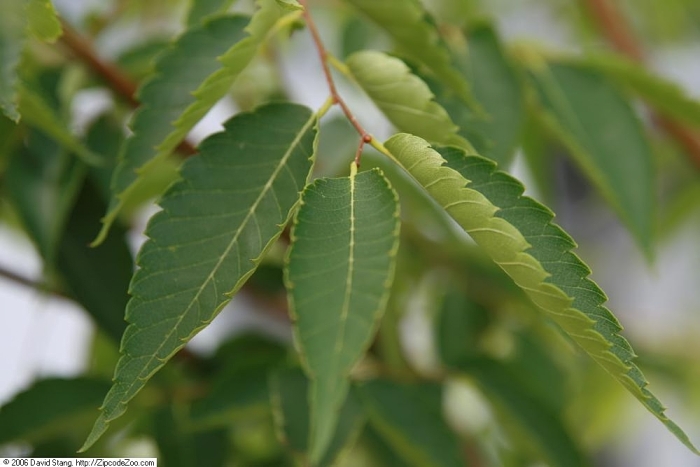Japanese Zelkova
(Zelkova serrata)
Japanese Zelkova (Zelkova serrata)
/
/

Photo by David J. Stang
CC BY-SA 4.0
Image By:
Photo by David J. Stang
Recorded By:
Copyright:
CC BY-SA 4.0
Copyright Notice:
Photo by: Photo by David J. Stang | License Type: CC BY-SA 4.0 | License URL: https://creativecommons.org/licenses/by-sa/4.0 | Uploader: David Stang | Publisher: Wikimedia Commons | Title: Zelkova_serrata_Green_Vase_1zz.jpg | Notes: {{Information |Description ={{en|1=Names: Clethra alnifolia L., Almindelig Konvalbusk, clèthre à feuilles d'aulne, Coast Pepper-Bush, coast pepperbush, coastal sweet pepperbush, Coastal Sweetpepperbush, Creel's Calico Summersweet, Creel's C...























































Estimated Native Range
Summary
Zelkova serrata, commonly known as Japanese Zelkova, is a medium-sized deciduous tree typically reaching 30 m (98 ft) in height, native to Japan, Korea, Taiwan, and parts of China where it grows in forest margins and along streams. It is characterized by a short trunk dividing into many upright and erect spreading stems forming a broad, round-topped head. The tree is known for its attractive bark that exfoliates to reveal orange patches, which can be quite striking in the winter landscape. The leaves are dark green and serrated, turning to shades of yellow, orange, or red in the fall, adding to its ornamental value. Japanese Zelkova is often used in urban environments due to its resistance to pollution and its ability to tolerate drought once established.
In cultivation, Japanese Zelkova is valued for its ease of maintenance, tolerance of a wide range of soil conditions including various pH levels, and its ability to withstand heat and some drought. It is commonly planted as a street tree, in parks, and as a shade tree in residential areas. It requires full to partial sun and prefers moist, well-drained soils. While adaptable, it benefits from fertilization with potassium and nitrogen to encourage vigorous growth and flowering. Pruning may be necessary to allow light into the inner canopy and maintain its shape. Propagation is through seeds, rooted stem cuttings, and grafting. Seeds require stratification at 5 °C (41 °F) for 60 days for improved germination rates. Young plants may need protection during their first winter. Potential problems include Dutch elm disease, though it is less susceptible than other elm relatives, and it can be potentially invasive outside its native range, so caution is advised.CC BY-SA 4.0
In cultivation, Japanese Zelkova is valued for its ease of maintenance, tolerance of a wide range of soil conditions including various pH levels, and its ability to withstand heat and some drought. It is commonly planted as a street tree, in parks, and as a shade tree in residential areas. It requires full to partial sun and prefers moist, well-drained soils. While adaptable, it benefits from fertilization with potassium and nitrogen to encourage vigorous growth and flowering. Pruning may be necessary to allow light into the inner canopy and maintain its shape. Propagation is through seeds, rooted stem cuttings, and grafting. Seeds require stratification at 5 °C (41 °F) for 60 days for improved germination rates. Young plants may need protection during their first winter. Potential problems include Dutch elm disease, though it is less susceptible than other elm relatives, and it can be potentially invasive outside its native range, so caution is advised.CC BY-SA 4.0
Plant Description
- Plant Type: Tree
- Height: 80-80 feet
- Width: 50-80 feet
- Growth Rate: Moderate
- Flower Color: N/A
- Flowering Season: Spring
- Leaf Retention: Deciduous
Growth Requirements
- Sun: Full Sun, Part Shade
- Water: Medium
- Drainage: Fast, Medium, Slow
Common Uses
Bee Garden, Butterfly Garden, Drought Tolerant, Street Planting
Natural Habitat
Forest margins and along streams
Other Names
Common Names: Saw-Leaf Zelkova , Water-Elm , Japanese Elm , Keyaki , Japansk Zelkova , Zelkova Tree , Sawleaf Zelkova , 느티나무 , 느틔나무 , 櫸;雞油 , Ju Shu
Scientific Names: Zelkova serrata , Corchorus hirtus , Zelkova serrata var. tarokoensis , Zelkova formosana , Zelkova acuminata , Zelkova keaki , Planera japonica , Zelkova tarokoensis , Zelkova hirta , Zelkova japonica
GBIF Accepted Name: Zelkova serrata (Thunb.) Makino